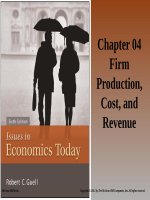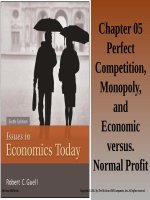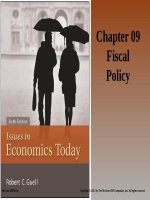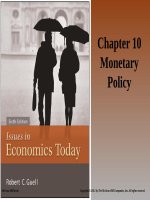Isues in economics today 6th by guell chapter02
Bạn đang xem bản rút gọn của tài liệu. Xem và tải ngay bản đầy đủ của tài liệu tại đây (200.63 KB, 34 trang )
Chapter 02
Supply
and
Demand
McGraw-Hill/Irwin
Copyright © 2012 by The McGraw-Hill Companies, Inc. All rights reserved.
McGraw-Hill/Irwin
Chapter Outline
•
•
•
•
•
•
•
Definitions
The Supply and Demand Model
All About Demand
All About Supply
Determinants of Demand
Determinants of Supply
The Effect of Changes in Price
Expectations on the Supply and Demand
Model
• Kick it Up a Notch: Why the New
Equilibrium?
2-2
Definitions
• Supply and Demand: the name of the
most important model in all economics
• Price: the amount of money that must be
paid for a unit of output
• Market: any mechanism by which buyers
and sellers negotiate price
• Output: the good or service and/or the
amount of it sold
2-3
Definitions (continued)
• Consumers: those people in a market who are
wanting to exchange money for goods or services
• Producers: those people in a market who are
wanting to exchange goods or services for money
• Equilibrium Price: the price at which no
consumers wish they could have purchased more
goods at that price; no producers wish that they
could have sold more
• Equilibrium Quantity: the amount of output
exchanged at the equilibrium price
2-4
Quantity Demanded and Quantity
Supplied
• Quantity demanded: how much
consumers are willing and able to buy at
a particular price during a particular
period of time
• Quantity supplied: how much firms are
willing and able to sell at a particular
price during a particular period of time
2-5
Markets
• Capitalism
• free markets in financial capital as well as goods and
services
• freedom to borrow or lend
• profits go to the owners of capital
• Communism
• capital and the profit that it generates is controlled
by a government authority.
• a government authority decides how the money is
used.
• Socialism
• a significant part of the profit generated by financial
capital goes to government in the form of taxes.
• a government uses the tax money to counter the
wealth impacts of the distribution of profit.
2-6
Heritage Foundation Index of
Economic Freedom
• Free
•
•
•
•
•
•
•
Hong Kong
Singapore
Ireland
Australia
United States
New Zealand
Canada
• Oppressed
•
•
•
•
•
•
•
Russia
Vietnam
Chad
Venezuela
Iran
North Korea
Cuba
2-7
•
The Scientific Method
and
Ceteris
Paribus
Scientists
• conduct experiments in laboratories.
• use replication and verification to ensure the accuracy
of their conclusions.
• Social Scientists
• cannot experiment on their subjects.
• must use models and look at the effects of individual
variables within those models.
• Economists
• hold variables constant within models to examine the
effect of other variables.
• use the Latin phrase ceteris paribus which means
“holding other things equal” to identify this is the case.
2-8
Demand and Supply
• Demand is the relationship between price and
quantity demanded, ceteris paribus.
• Supply is the relationship between price and
quantity supplied, ceteris paribus.
2-9
The Supply and Demand Model
2-10
The Demand Schedule
• The Demand Schedule
presents, in tabular form, the
price and quantity demanded for
aPrice
good. Individual QD QD for 10,000
$0.00
$0.50
$1.00
$1.50
$2.00
$2.50
5
4
3
2
1
0
50,000
40,000
30,000
20,000
10,000
0
2-11
Figure 1 The Demand Curve
P
$2.50
$2.00
$1.50
$1.00
Demand
$0.50
0
0
10
20
30
40
50
Q/t
2-12
The Supply Schedule
• The Supply Schedule presents, in tabular
form, the price and quantity supplied for a
good.
Price
Individual Qs
$0.00
$0.50
$1.00
$1.50
$2.00
$2.50
0
0
1,000
2,000
3,000
4,000
QS for 10
firms
0
0
10,000
20,000
30,000
40,000
2-13
Figure 2 The Supply Curve
P
$2.50
Supply
$2.00
$1.50
$1.00
$0.50
0
0
10
20
30
40
50
Q/t
2-14
Equilibrium, Shortages, and
Surpluses
• Equilibrium is the point where the
amount that consumers want to buy and
the amount that firms want to sell are
the same. This occurs where the supply
curve and the demand curve cross.
• Shortage (Excess Demand): the
condition where firms do not want to sell
as many as consumers want to buy.
• Surplus (Excess Supply): the
condition where firms want to sell more
than consumers want to buy.
2-15
A Combined
Supply and Demand Schedule
Price
$0.00
$0.50
$1.00
$1.50
QD
QS
Shorta Surpl
ge
us
50,000
50,00
0
0
40,00
0
40,000
0
30,00 10,00 20,000
0
0
20,00 20,00
2-16
Figure 3
The Supply and Demand Model
P
$2.50
Supply
$2.00
Equilibrium
$1.50
$1.00
Demand
$0.50
0
0
10
20
30
40
50
Q/t
2-17
All About Demand
• The Law of Demand
• The relationship between price and
quantity demanded is a negative or
inverse one.
2-18
Why Does the Law of Demand
Make Sense?
• The Substitution Effect
• moves people toward the good that is now
cheaper or away from the good that is now
more expensive
• The Real Balances Effect
• When a price increases it decreases your
buying power causing you to buy less.
• The Law of Diminishing Marginal
Utility
• The amount of additional happiness that you
get from an additional unit of consumption falls
with each additional unit.
2-19
The Law of Supply
• The Law of Supply is the statement that
there is a positive relationship between
price and quantity supplied.
2-20
Why Does the Law of Supply
Make Sense?
• Because of Increasing Marginal Costs
firms require higher prices to produce more
output.
• Because many firms produce more than one
good, an increase in the price of good A
makes it (at the margin) more profitable so
resources are diverted from good B to
produce more of good A.
2-21
Determinants of Demand
• Taste
• Income
• Normal Goods
• Inferior Goods
• Price of Other Goods
• Complement
• Substitute
• Population of Potential Buyers
• Expected Price
• Excise Taxes
• Subsidies
2-22
Movements in the Demand Curve
Determinant
Result of
an
increase
in the
determina
nt
Result of a
decrease in
the
determinan
t
Taste
D shifts
right
D shifts left
Income-Normal Good
D shifts
right
D shifts left
Income-Inferior Good
D shifts left D shifts right
Price of Other GoodsComplement
D shifts left D shifts right
Price of Other GoodsSubstitute
D shifts
right
D shifts left
Population of Potential
Buyers
D shifts
right
D shifts left
2-23
Figure 4 The Effect of an Increase
in Demand
P
$2.50
Supply
New Equilibrium
$2.00
$1.50
Old Equilibrium
$1.00
New Demand
Demand
$0.50
0
0
10
20
30
40
50
Q/t
2-24
Figure 5 The Effect of a Decrease
in
Demand
P
$2.50
New Equilibrium
Supply
$2.00
$1.50
Old Equilibrium
$1.00
$0.50
New
Demand
0
0
10
20
30
40
Demand
50
Q/t
2-25









